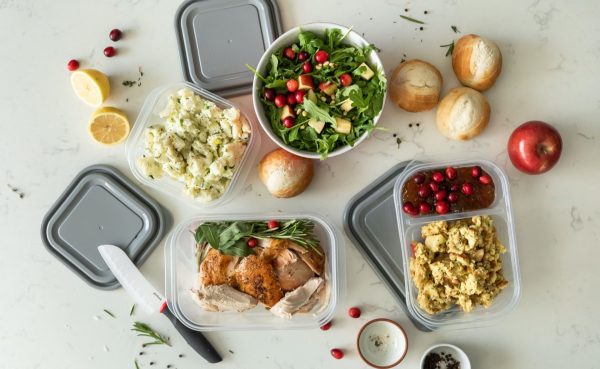
Image Credit: GoodCook
A version of this post originally appeared on GoodCook.com. Thanks to our friends at GoodCook for the excellent tips!
An epic Thanksgiving feast is a meal we all look forward to, but to many, the leftovers are the real standout. Everything from the turkey to the sides can be repurposed into tasty new meals. Properly handling and storing leftovers is key to preventing food spoilage and keeping your family safe. That means following food safety rules and using airtight containers to properly seal your food.
A few days before Thanksgiving, clean out your fridge and make space for all of the containers you expect to use. Make sure you have plenty of containers on hand for all of your leftovers.
How long can you leave Thanksgiving dinner out on the table?
Perishable food should not be left out for more than 2 hours. Ideally, you want to keep hot food hot and cold food cold. Begin packing up leftover food and refrigerating them within 2 hours.
The Best Way to Store Leftovers
Whether you’re packing away the green bean casserole or the mashed potatoes, don’t store food in the dishes that you cooked in. Pack leftovers into several containers. If the containers feel hot, stack them side by side instead of on top of each other until they cool down – otherwise, you’ll be trapping heat between the containers. Avoid opening and closing the fridge door until the leftovers cool down.
Carve and pick the turkey clean of meat and skin and portion it into a container. If the turkey cavity is stuffed, scoop out the stuffing and store it separately from the turkey.
Best practice for reheating leftovers
Instead of reheating your entire spread of leftovers, heat up only the portion that you plan to eat. It’s fine to reheat food and put the rest back in the fridge, but you’ll lose flavor and change the texture of your food.
Leftovers should be reheated to an internal temperature of 165° F. The safest way to check is with a food thermometer. Bring leftover sauces, soups and gravies to a full boil before consuming. For microwaved food, cover and rotate the leftovers while reheating to ensure even reheating.
Should food come to room temperature or go straight in the refrigerator?
Food doesn’t have to come to room temperature before being stored in the fridge. Let your food cool down as quickly as possible before portioning it into a container within a 2-hour timeframe. If your food is steaming hot, you can put ice in a large bowl and place your hot dish in a container over the ice. The risk of putting hot food straight into the fridge is that it raises the internal fridge temperature, and everything in your fridge will take longer to cool down.
How long can leftovers be kept in the fridge?
The general rule of thumb is to consume leftovers within 4-5 days of storing them in the fridge. We listed the optimal dates your favorite Thanksgiving food should be consumed by, via Stilltasty.com:
- Cooked Turkey can be stored in the fridge for up to 4 days.
- Stuffing can be stored in the fridge for up to 4 days.
- Roasted vegetables can be stored in the fridge for up to 4 days.
- Mashed potatoes can be stored in the fridge for up to 5 days.
- Scalloped potatoes can be stored in the fridge for up to 5 days.
- Sweet potato casserole can be stored in the fridge for up to 5 days.
- Green bean casserole can be stored in the fridge for up to 5 days.
- Homemade Gravy can be stored in the fridge for up to 2 days, and canned gravy can be stored in the fridge for up to 5 days.
- Cooked green beans and cooked carrots can be stored in the fridge for up to 5 days.
- Cranberry sauce can be stored in the fridge for up to 2 weeks.
What’s the best way to freeze leftovers?
Leftovers should be frozen within three days. Portion out what you and your family will eat in a few days and freeze the rest. Divide and freeze the leftovers in airtight containers.Smaller portions allow leftovers to thaw more easily.
Make sure the leftovers have cooled completely before freezing. You may need to refrigerate the leftovers for a few hours before freezing. For soups, gravies and other liquids, leave some space at the top of each container, since liquids expand slightly as they freeze. Make sure to label and date your leftovers before freezing!
When ready to thaw, place the frozen leftovers in the fridge overnight before reheating. Once the leftovers have been thawed, they should not be re-frozen. Technically, food can be frozen indefinitely at 0°F, but for optimal flavor purposes, consume the foods below by the dates listed:
- Stuffing can be stored in the freezer for up to 1 month.
- Cranberry sauce can be stored in the freezer for up to 2 months.
- Green bean casserole can be stored in the freezer for up to 2 months.
- Roasted vegetables can be stored in the freezer for up to 3 months.
- Cooked turkey can be stored in the freezer for up to 3 months.
- Gravy can be stored in the freezer for up to 3 months.
- Mashed potatoes can be stored in the freezer for up to 12 months.
- Scalloped potatoes can be stored in the freezer for up to 12 months.
- Sweet potato casserole can be stored in the freezer for up to 12 months.
- Cooked green beans and cooked carrots can be stored in the freezer for up to 12 months.
Need some creative ideas for using those leftovers? Try our “leftover lunch” recipes!
